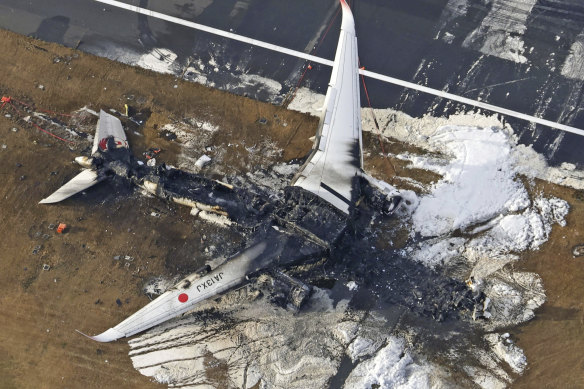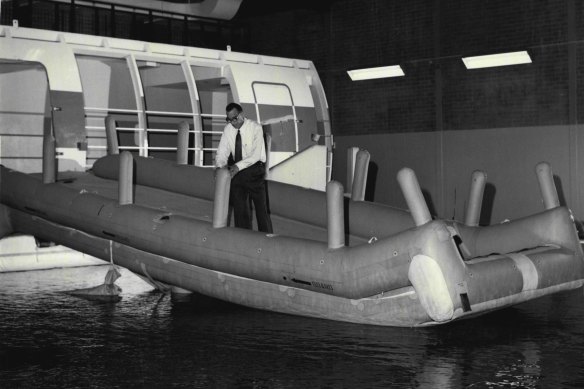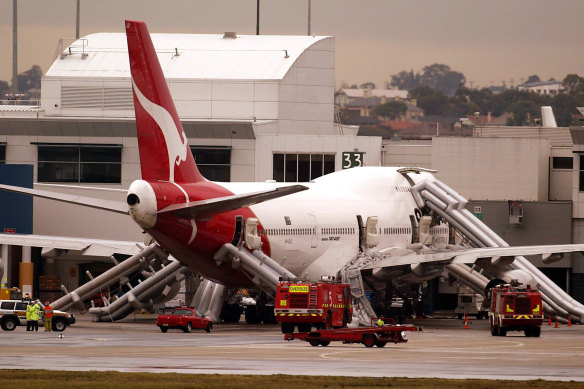- Analysis
- Travel news
- Air travel
The Australian invention that saved countless plane passengers’ lives
As passengers of Japan Airlines Flight 516 slid down the escape chutes of their burning Airbus on a midwinter Tokyo night, no doubt they were thanking the lucky stars above them.
But there’s another star in the distant annals of aviation that they may one day care to thank for their miraculous survival.

The burnt-out Japan Airlines plane that collided with another aircraft on Tuesday evening. All 379 passengers and crew safely evacuated, though five people on board the other plane were killed.Credit: AP
His name is Jack Grant, the 1921-born Australian inventor of those now mandatory chutes that contributed significantly to this week’s amazing saving of 379 lives, including 12 Australians.
Sadly, five crew aboard the Japan Coast Guard Dash-8 also involved in the dramatic incident at Tokyo’s Haneda Airport were not as fortunate.
Grant, in his role as operations safety superintendent at Qantas, was recognised in 1975 as the inventor of the revolutionary “slide-raft” by the Guild of Air Pilots and Air Navigators (now known as the Honourable Company of Air Pilots) in London for outstanding achievements in aviation.
Grant is pictured in a newspaper archival photo from the same year with his invention shown floating on water, a key feature of his buoyant raft-like creation.

Jack Grant shows off his invention in 1975.Credit: Fairfax Media
While escape slides have mainly been deployed on land following accidents and emergencies, they were successfully activated by the heroic crew of US Airways Flight 1549 in 2009 after it made its famed emergency landing on New York’s Hudson River.
Footage and photos from the incident show the chutes fully extended and floating like a pair of extra wings on the surface of the frigid water.
No matter how brilliantly efficient cabin crews are in organising evacuations from often smoke-filled airline cabins, a certainty remains. Without the ingenious aid of these escape chutes, fewer passengers would survive and more would be injured, leaping metres to the ground from stricken aircraft.

Slides were deployed from a Qantas jumbo jet at Sydney Airport in 2003 after smoke was detected in the cabin. Passengers evacuated safely though three were injured during the process.Credit: AP
“Aircraft escape slides are an essential piece of safety equipment,” says Airbus, the manufacturer of JAL’s burnt-out Airbus A350-900. “They are a powerful and efficient means of ensuring safe exit from an aircraft in case of an emergency.”
International aviation safety regulations require escape slides to be deployable in 10 seconds, part of the recommended and astonishingly brief 90-second time limit crew are given to evacuate all passengers before flames and smoke fatally take hold.
While airliner escape slides have been credited with saving innumerable lives, they are not foolproof.
Injuries, albeit minor and in relatively low numbers, do occur during evacuation procedures, the most common being wounds caused by friction with the chute itself.
But more serious injuries tend to occur from jumping, without slides, from the wings of aircraft after escaping via exit rows and other parts of the cabin.
It’s vital that passengers do not take, or attempt to take, their belongings with them when evacuating an aircraft. This can not only fatally slow the process but also, in the case of items such as high heels, damage the chute fabric.
Typical of some other Australian inventions, such as the CSIRO-developed Wi-Fi, some credit for early versions of the aircraft escape slide was attributed to another party, namely James F. Boyle, inventor of the World War II life vest, the “Mae West”.
But there’s no doubt of the contribution and legacy of Australia’s Jack Grant, and for that matter, Qantas, to the safety of mass air travel.
The Tokyo accident also marks the first time an Airbus A350 – a modern aircraft launched in 2015 – has been destroyed by fire.
The plane is Airbus’ first model to be constructed largely of carbon fibre composites (the same as the Boeing 787 Dreamliner).
“It’s a watershed event in aviation safety,” says Andreas Spaeth, an aviation journalist and co-host of a podcast that examines historic plane crashes, told London’s Telegraph.
“This was an aircraft that was absolutely full. So to see that everyone escaped safely is a miracle.
“Even then, it was a fairly long time before a big fire emerged. We have never seen a fuselage made of carbon fibre burn. And the structure held up pretty well.”
After the successful JAL evacuation, coupled with the tragic outcome of the coast guard aircraft, attention will turn to another vital Australian invention – the black box flight, cockpit and voice recorder, conceived in the 1950s by Northern Territory-born research scientist David Warren.
Anthony Dennis is editor, travel, of The Sydney Morning Herald and The Age.
Sign up for the Traveller newsletter
The latest travel news, tips and inspiration delivered to your inbox. Sign up now.